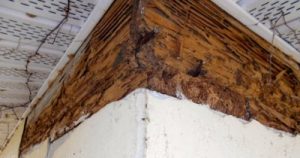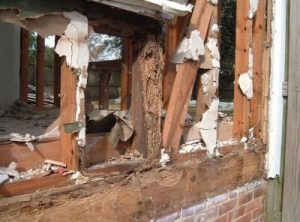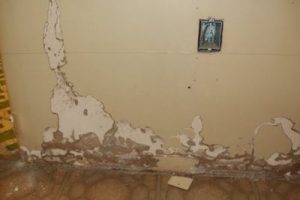
Subterranean termite is a real hidden danger.
The insect leads a highly secret way of life, that is why sometimes it is very difficult to identify the presence of termites’ colony nest inside your house.
Hide content
- How to Identify Termite Damage Inside your House?
- Visible and Hidden Signs of Damage
- How Does the Initial Damage Look Like?
- Photo
- Useful articles
- Helpful video
- Conclusion
How to Identify Termite Damage Inside your House?
There are ways that will help you to discover the presence of subterranean termites inside and outside your dwelling by your own.
Recommendation: if you do find the evidence of termites’ infestation, it is highly advisable not to resort to do-it-yourself treatment activities. You should immediately contact the local expert on termites, because the consequences of such negligence could be irretrievable.To recognize the activity of subterranean termites inside and outside your house, you need a good flashlight, screwdriver or pocketknife and coveralls.
First of all, you should pay attention to damp and warm places (basement), the exterior and interior surfaces of the foundation, particularly construction where wood is on or near the soil.
How to check for termite damage? Start your inspection with the basement and use a bright flashlight.Search for mud tunnels, rotten structures and the activity of the swarmers.
You should examine the following areas as well:
- all wood constructions and materials in the basement and inside the hard-to-get-to spaces;
- all sills, sub floors, joists, support posts, supporting piers, basement window frames, wood under porches;
- take close notice on places where one can find concrete flooring: steps, porches, or slabs join the wooden structure;
- any scrap wood on the exterior of your house, old and rotten tree stumps, fence posts and basement windows exterior frames.
On the right picture you can see the example of termite damage in door frame.
It is necessary to note, that termites damage not only hard-to-get or damp places as basement or garage, they can also damage your living and bedrooms: pay a close attention to walls, ceiling and floors.What does termite damage look like on wood? Here you can find early signs of termite damage such as mud tunnels (the most prevailing feature). Inspect window frames and doorways: piles of swarmers’ wings and termite frass are the most evident signs of infestation there.
Learn more about subterranean termites: signs of their activity; best methods of treatment and DIY methods. Eastern subterranean termites and their tunnels and tubes with photo.
Now, when you have an idea about how to tell termite damage or how to determine termite damage let’c move to the different signs of harm from these pests.
Visible and Hidden Signs of Damage
To destroy the structural integrity of a house for termites is a matter of time. The serious structural damage looks like:
- rotten and hollow like joisting;
- rotten and hollow like roof timber;
- invaded basement structures;
- patterns and holes in framework;
- swollen ceilings and floors.
But this is an extreme case and the result of many years’ “work”. To protect your house against pests, make annual inspection of enlisted above areas for the following visible termite damage signs:
- Termites frass (droppings). These droppings, also called frass or poop, are wood colored. Such droppings can be found on a bed (the sign of “roof” activity), on window sills, carpet, floor.
- Piles of wings. The shed wings of swarmers is a true sign that the subterranean termites have entered their next phase of development. You can often found shed wings on the windowsills.
- Pattern in the wood. Subterranean termites eat and destroy soft wood and eat along the grain. This causes an evident and highly visible honeycomb pattern inside the wood.
- Subterranean termites mud tubes. The most unmistakable sign. The tube provides shelter for the foraging termites, they pass through this tunnel to work and find food and moisture for feeding. The tubes are flattened and muddy looking. Most tubes are about the width of a pen. They are most evident when they are extending over concrete foundations and other exposed surfaces.
Advice: if you have found a structure similar to mud tube, there is a way to check whether it is active or abandoned: if you want to receive evidence, that you have found exactly a mud tube made by subterranean termites, you can remove the portion of a tunnel with a screwdriver and see if there are still termites inside.If you see an active movement inside with termites running back and forward it means, that you have a serious infestation. If the tunnel is empty, you can check it in a few days and see, whether the tube is repaired.
Warning: even if it is not repaired it does not mean, that the insects have abandoned your house for ever. It means, probably, that they have built a new tube somewhere nearby.But there are also a number of hidden signs of termite damage in home. Pay a close attention to the following evidences:
Damaged or hollow-sounding wood. While termites lead the veiled way of life and prefer dark and secret places, they can destroy wood material from the inside, at the same time the wood external appearance stays normal.
If wood sounds hollow when tapped, it may be because termites are eating the wood from the inside out. Also, damaged wood when opened looks layered and rotten with a great number of frass.
Sounds. Performing a periodical inspection of your house, take a large screwdriver and knock it at wood sections and walls. If the wood sounds hollow, it may have been damaged with insects.
Inside the house, put a stethoscope or similar instrument to the various walls. You will not hear the termites, but once carpenter ants digging in their cells, they are producing a quiet rustling.
Deformation. Subterranean termites devour soft wood and eat along the grain.
This produces a distinct honeycomb pattern in the wood.
It is crucial to stop subterranean termites as soon as the infestation is discovered.
Also, one can discover deformed furniture, ceiling and floor joists, stairs and other wooden structures: termites eat the wood from the inside, that is why it sound hollow. Rotten and eaten through wood could be deformed.
Smells. Termites do not produce any smells. One can smell just rotten wood and a smell of mold in damp places of a house.
If you smell rotten wood, pay a close attention to this very wooden structure: it is possibly damaging by subterranean termites.Learn more about drywood termites: signs of their activity; best methods of treatment: spot treatment and DIY methods; how to get rid of them in furniture?
How Does the Initial Damage Look Like?
It is very important to discover termite infestation at initial stages of a damage. The most common way they get into your house is through wood to ground contact, such as a door frame, deck posts, or wood support beams. Firstly, inspect these areas for some frass or rotten wood.
Also, a piles of swarmers’ wing on windowsills is a sign, that there might be a termites’ colony inside your house and their number is multiplying.
Termites’ frass is another initial sign of infestation. A pile of brown sawdust-like material on window frames, furniture or floor means, that termites have already began to build their mud tunnels throughout your house to get moisture and food.
Be careful! It is crucial to stop subterranean termites as soon as the infestation is discovered. It is better to call a local specialist on this matter.An active part of initial house damage is, undoubtedly, mud tunnels or tubes. It could mean, that a termite colony inside your house has a tendency to grow, working termites are looking for new food and moisture sources and will definitely found new and new colonies that will badly affect your house in the future.
Warning! If you have traced an underground nest via mud tubes, or just have found such nest under the old and rotten wooden structures, do not try to remove or destroy it by your own, it can be dangerous! Contact the local termite control service for professional consultation.Here you can learn more information about effective treatment method called tenting (fumigation): dangers for termites, preparing for fumigation and cleaning after, how long does this procedure last?
Photo
See what termite damage looks like on pictures below:
Useful articles
If you interested in more information of termites we recommend you to read the following articles:
- All types of termites. Are they harmful to humans? Can they bite you? And what is the difference between drywood and subterranean ones?
- What does swarmers of different species look like: drywood, subterranean, formosan?
- Signs of infestation outside and in the house: in walls or furniture.
- What does termite holes look like? What is droppings and is it toxic to humans? Do termites make noises?
- Posible termite damage Examples of damage in walls and wood floors.
- All about flying termites: how do they look like, swarming season and what to do if there are swarmers in your house?
- How do they do nests and mounds? How to find it in your garden or inside the house?
- Termite life cycle – from egg to larvae. And social hierarchy: workers, soldiers, queen.
Helpful video
How to identify termite damage? Example of dry wood evidence of termite damage:
Conclusion
The best option is to prevent the termites’ infestation inside your house, though they are not always possible to detect before these insects become a real problem. Use the signs of insects inside your house that were given above for your periodical inspection.
Remember, that there are many accessible and safe methods to destroy termites’ colony today. But only a specialist from termite control service will help you to choose the best option how to get rid of the pests inside your house for a long-time.









